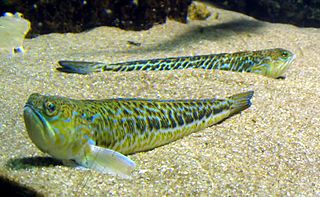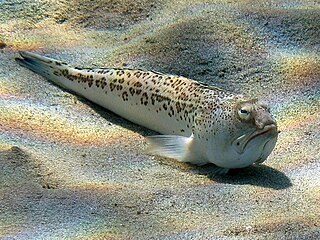
The Moorish idol is a species of marine ray-finned fish belonging to the family Zanclidae. It is the only member of the monospecific genus Zanclus and the only extant species within the Zanclidae. This species is found on reefs in the Indo-Pacific region.

Weevers are nine extant species of ray-finned fishes of the family Trachinidae in the order Perciformes, part of the wider clade Percomorpha. They are long, mainly brown in color, and have venomous spines on their first dorsal fin and gills. During the day, weevers bury themselves in sand, just showing their eyes, and snatch prey as it comes past, which consists of shrimp and small fish.

The greater weever is a benthic and demersal venomous marine fish of the family Trachinidae. The greater weever is widely distributed along the eastern Atlantic coastline from Norway to Morocco, extending to the Mediterranean, Aegean and Black Seas. Trachinus draco has been shown to occur in depths ranging from shallow water up to -150 meters where it inhabits mostly muddy or sandy grounds. Trachinus draco is mostly and notoriously known for its venomous spines that can inflict serious injuries on humans through accidental stinging. Because of these spines and its potent venom it is classified as one of the most venomous fishes in the Mediterranean. The name "weever" is thought to originate from the Anglo-Saxon word "wivre" which translates as "viper".

The spotted weever is a fish of the family Trachinidae, order Perciformes, and class Actinopterygii.

Guinea-Bissau is a West-African country rich in biodiversity.

Alepes is a genus containing five extant species of tropical marine fishes in the jack family, Carangidae. They are commonly known as scads, a term applied to many genera of carangid fishes. Their body form, however, differs from these other scads by being much more ovate in shape, more similar to the larger jacks taken as game fish, although scads are generally much smaller. They are found in coastal waters throughout the Indo-West Pacific region.

Pteroplax is an extinct genus of embolomerous anthracosaur. Only one species has been described; the skull table noted is the lectotype of this species. Pteroplax dates from the late Carboniferous Period, about 315 million years ago. It is known with certainty only from Newsham in Blyth, Northumberland, England. At that site, it shared a coal-swamp lake habitat with the larger embolomere, "Eogyrinus". Pteroplax probably grew up to about 10 ft (3.0 m) in length and was largely aquatic, feeding upon fish and smaller tetrapods. It likely had a long, eel-like body, with short limbs and a long tail.

The common shiner is a freshwater fish of the family Cyprinidae, found in North America. It ranges in length between 4 and 6 inches, although they can reach lengths of up to 8 inches (20 cm).
T. cornutus may refer to:

Trachinus is a genus of weevers, order Perciformes that consists of seven extant species. Six of the genus representatives inhabit the waters of Eastern Atlantic Ocean, but only one, Trachinus cornutus, inhabits the South-Eastern Pacific Ocean. Three of the Atlantic species occur near the coasts of Europe. An eighth extinct species, T. minutus, is known from Oligocene-aged strata from the Carpathian Mountains, while a ninth species, also extinct, T. dracunculus, is known from middle-Miocene-aged strata from Piemonte, Italy.

The ridged-eye flounder, also known as the frog flounder, is a species of flatfish in the family Pleuronectidae. It is a demersal fish that lives on sand and mud coastal bottoms at depths of between 2 and 170 metres. Its native habitat is the temperate waters of the north-western Pacific, from southern Hokkaido to the Korean peninsula, the Bohai Sea, the Yellow Sea and the South China Sea. It can grow up to 30 centimetres (12 in) in length, and can weigh up to 1 kilogram (2.2 lb).
Parablennius cornutus, the horned blenny, is a species of combtooth blenny found in the southeast Atlantic ocean: northern Namibia to Sodwana Bay, South Africa. This species can reach a length of 15 centimetres (5.9 in) SL.
In the 10th edition of Systema Naturae, Carl Linnaeus described the Pisces as:
Always inhabiting the waters; are swift in their motion and voracious in their appetites. They breathe by means of gills, which are generally united by a bony arch; swim by means of radiate fins, and are mostly covered over with cartilaginous scales. Besides the parts they have in common with other animals, they are furnished with a nictitant membrane, and most of them with a swim-bladder, by the contraction or dilatation of which, they can raise or sink themselves in their element at pleasure.

The starry weever, or streaked weever is a fish of the family Trachinidae widespread in the eastern Atlantic from Gibraltar to the Gulf of Guinea, and probably further south; it is also known from the Mediterranean Sea. A marine subtropical fish, it grows up to 50 cm (20 in) in length.
The Guinean weever is a fish of the family Trachinidae, widespread in the eastern Atlantic along the coasts of Africa from Mauritania to Angola. A marine, tropical, demersal fish, it grows up to 35 centimetres (14 in) length.
The sailfin weever, Trachinus collignoni, is a fish of the family Trachinidae, order Perciformes, and class Actinopterygii. Widespread in the Eastern Atlantic along the tropical coast of west Africa, Gabon and Congo, probably further north and south. Marine tropical fish, up to 15 centimetres (5.9 in) in length.
Trachinus pellegrini, the Cape Verde weever, is a fish of the family Trachinidae. Widespread in the eastern Atlantic along the coasts of Senegal to Nigeria, including the Canary Islands and Cape Verde, and also reported from Mauritania, it is a marine tropical demersal fish, up to 20 centimetres (7.9 in) in length. The species was named and described by Jean Cadenat in 1937 and the specific name honours the French ichthyologist Jacques Pellegrin (1873–1944), who worked at the Muséum National d'Histoire Naturelle in Paris.
The striped weever, Trachinus lineolatus, is a fish of the family Trachinidae. Widespread in the Eastern Atlantic from Guinea-Bissau to São Tomé Island and Gabon, it is a marine tropical demersal fish, up to 15 centimetres (5.9 in) in length.

Citharichthys cornutus, the horned whiff, is a species of flatfish in the large-tooth flounder family Paralichthyidae. This bathydemersal marine fish inhabits the continental shelves of the western Atlantic Ocean, in both tropical and subtropical waters. It ranges from New Jersey in the north to Uruguay in the south, though larvae samples have also been collected off the coast of Canada. It occurs at depths between 30 and 400 metres, though it is usually found in deeper waters.

Trachinocephalus trachinus, also known as the Indo-Pacific blunt-nose lizardfish is a species of fish in the family Synodontidae found in Indo-Pacific. Although previously synonymized with T. myops, Polanco et al. (2016) demonstrated that the two are distinct in the number of lateral-line scales and other meristics, and resurrected T. trachinus for the Indo-Pacific population. This species grows to a length of 40 centimetres (16 in) TL.











